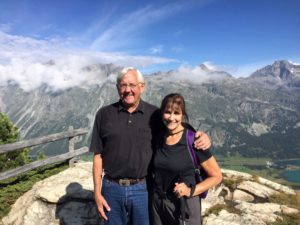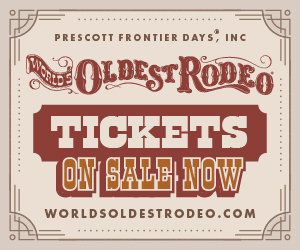With that genuine and authentic nature that he had, you saw his heart.
“I was born about 100 years too late,” Jim Babbitt would say with a wistful grin as he’d stroll around the downtown checking in on merchants, visiting with friends over coffee or longing for what mattered most to him – a simpler time, when people greeted each other on the street and wrapped their arms around the community – a time when the meaning of things was more important than the acquiring of things.
“We loved the quiet special times, mostly long walks,” said Helene Babbitt, who was married to Jim for 48 years. “We loved to travel – Jim just fit in with the culture wherever we were. We’d feel so special visiting the trading posts and attending Hopi religious dances, such as the bear dance where the women would bring their children to have them blessed.”
This third generation Arizona Babbitt is remembered as authentic, understated and substantive as the time-worn sandstone bricks of the historic Babbitt Brothers Building on the corner of San Francisco St. and Aspen Ave. Jim had a quiet, yet revered and undeniable, presence that served as a source of encyclopedic knowledge and steadfast perseverance to those seeking to uncover, preserve and honor the past. He was a role model to younger people who aspired to be like him and an inspiration to those who knew he could make things happen, like start a movement to restore old buildings and historic places.
“There were those who wanted to demolish our old buildings, but Jim was one of the few who said, ‘No, we’ll maintain the history.’ Plus, he had the contacts and his word was trusted,” said Weatherford Hotel owner Henry Taylor.
Babbitt’s Backcountry Outfitters owner Keith Harris calls Jim “inseparable” from the downtown. “I have to remind people all the time, if you didn’t know Jim, look outside, that’s Jim – Heritage Square, the trees, the bricks, the benches with the train wheels. He had a vision and he was able to carry it out.”
“For me, Jim was like the mortar of Flagstaff – keeping it together,” said Late for the Train owner Dave Dobrick. “Jim was never a showy guy, but he was always creating and doing and very aware and alert to the feel of the town. It was never about him, it was about relationships that would be carved out on a business-to-business level. He became my landlord and customer, but over time I came to see that he appreciated his relationships on a deeper level. I wouldn’t be here without him. It’s that simple.”
Home-Grown Values
Jim Babbitt was born in Flagstaff on March 15, 1948. He was the fifth of six children born to Paul and Frances Babbitt. His grandfather was Charles “C.J.” Babbitt, one of the original Babbitt brothers who came to Arizona from Ohio in 1886 to start a ranching empire. Jim’s brother, former Arizona Governor and U.S. Secretary of the Interior Bruce Babbitt, says Jim’s values were forged in the environment he loved and by the people he admired.
“Flagstaff for us was a very different place then,” said Bruce. “It was a small rural town of about 3,000 to 4,000 people. We roamed with the neighborhood kids in the out-of-doors. The grade school was two blocks away. On autumn mornings, we’d go deer hunting before class. We were right there in the middle of all that, the rural outdoor life. And we had a lot of wonderful experiences together.”
Even as a boy, Jim was known as kind and humble, recalls Bruce. “He managed to make so many friends because he was really interested in people. He made them feel that they were important. He was always working on new projects with new enthusiasm and never taking credit for any of them, just doing his thing.”
Bruce describes their hometown as a place where everybody worked together and nobody was more important than anybody else. “Jim was a product of a different era in a community that valued enduring relationships. He was deeply attached to history, tradition and all the surroundings that he knew well. Jim’s work to reinvigorate Flagstaff was a reflection of the environment he grew up in. His sense was we had to work hard to preserve those kinds of values.”
“We had a very close family, very outdoors oriented because of our father,” said Jim’s brother Charles Babbitt. “We spent a lot of time in the natural world on picnics, getting wood and pursuing Dad’s interest in fossils. As adults, Charles says some of the best times they spent together were on hikes in the Grand Canyon, around Rainbow Bridge at Lake Powell, and at Blue Spring, which feeds the Little Colorado River. “Hiking really brings out a lot of what a person is about. Jim had a great sense of humor, was always inquisitive about what was going on and always owned up to our misfortunes. One night we were camped out in our sleeping bags and the pots and pans were rattling. In the morning we realized kangaroo rats had left us without any food!”
Peering into the Past
In the early 1990s, Babbitt Brothers Trading Company was at a crossroads. The board of directors was liquidating much of the company. The Babbitt Brothers Building, which covered an entire city block and housed Babbitt’s department store, was up for sale.
“Jim was crawling around in the building. He was in the attic and in crawlspaces and saw sandstone. They had covered the whole outside of this building to make it look modern,” said Babbitt Ranches President Billy Cordasco, Jim’s cousin. “He took me on the stairway, shined his flashlight behind the façade and showed me that the building was still intact.”
Cordasco says Jim got creative and figured out a way for the Babbitt Brothers Foundation to buy the original Babbitt Brothers building from the company and use it as a non-profit organization to give back to the community. From the rent of the building’s spaces to downtown merchants and apartment tenants, Jim started the Viola Awards in memory of Viola Babbitt, a long-time patron of the arts, to honor Flagstaff’s arts and science excellence. Funds generated also support historic preservation, community health and educational endeavors.
“All the historic renovation, the accuracy of the preservation, came through Jim’s fingers and his efforts. And from that spawned all of the historic renovation downtown,” said Cordasco.
A Passionate Steward
When Stewart Udall was U.S. Secretary of the Interior, he wrote the book, “The Quiet Crisis,” in 1963. In the preface of the book is a poem by Galway Kinnell, “Another Night in the Ruins.” And this particular passage is how Karen Underhill thinks of Jim.
“The bonfire you kindle can light the great sky— though it’s true, of course, to make it burn you have to throw yourself in …”
“Jim was a passionate steward of this place we call home – culturally and environmentally,” she said.
Underhill, now retired as the head of NAU’s Cline Library Special Collections and Archives, says the two of them had great fun exploring the archives together. “He was a scholar at heart with a Western flair. He was a Renaissance man in that he had many passions and interests. He was humble but stood up for what he believed was right. He was the best of the best as a human being.”
She says, Jim cared. “He cared about this region, he cared about inclusivity, he cared about our Native people, he cared about Flagstaff, our forests, our environs, our riparian areas. He cared about protecting this place.”
“Jim loved Flagstaff. He took a very active, effective and productive interest in the town,” said Charles. “From a historical perspective, he was the driving force and he did a lot to make Flagstaff a better community by being on the zoning board and working with other downtown merchants to develop the downtown. He contributed mightily.”
Jim was honored by the Arizona Historical Society, wrote several books and served on a number of boards including for the Grand Canyon Trust, the Grand Canyon Conservancy and the Museum of Northern Arizona.
“Jim was one of our longest-serving and most admired trustees,” said Grand Canyon Trust Executive Director Ethan Aumack. “Jim was a beautiful, kind, quietly earthshaking person. He had a profoundly positive impact on Flagstaff, Grand Canyon and the Colorado Plateau. I and so many others I know miss him deeply already.”
Grand Canyon Conservancy Chief of Communications, Partnerships and External Affairs Jan Bolsom calls Jim Babbitt a lifelong friend of the Grand Canyon. “He had a knowledge that is irreplaceable. His kindness and gentleness will be missed.”
Former MNA Director Robert Breunig calls Jim one of the most knowledgeable people about the history of Northern Arizona and Flagstaff. “He really knew that history well, he often did talks on historical subjects and was particularly knowledgeable about the trading posts on Hopi and Navajo reservations. What we are losing is a really important part to our cultural memory of Northern Arizona and the intersection of different types of people.”
Jim also was a big fan of President Theodore Roosevelt, known as the country’s “Conservationist President.” He had the honor of naming a particular location at the North Rim, “Roosevelt Point.”
A Mentor and Friend
Harris worked for Jim for 20 years before he became owner of Babbitt’s Backcountry Outfitters in 2011. “It was a privilege to hang out with him every day,” he said. “He stopped me on the sidewalk out here and asked if I wanted to buy the business. There was no way I could buy it, but he said, ‘We’re going to make it happen,’ and he walked away. He changed my life right there in that moment.”
Harris recalls Jim’s collection of antique machinery like old printing presses and mountains of historic photos and postcards. “He was our liaison to the past, the historian for Flagstaff. He sat up here researching history,” Harris said about the loft in Babbitt’s Backcountry Outfitters. “He loved to find old Babbitt logos and had a real interest in creating and printing. Jim created the “Don’t PHX FLG” bumper sticker and at one time wanted to start a newspaper. I always looked at Jim as an umbrella over us all. He was just full of life and always pursued his hobbies. He taught me how to live life. I wanted to be that person. I’ve learned more from him than probably anybody else and I felt this security knowing he was there.”
Dawn Begley worked with Jim as the Heritage Square special events coordinator. “Every conversation with Jim was a gift,” she said. “Whether it was about the history of Flagstaff and how to preserve it, advice on running, the fact that he had decided to give up running and take up yoga, or my favorite, that he was growing his hair out because he joined a band.”
Jim took up the banjo later in life. Helene said, “He enjoyed the fact that people thought it was a funny instrument.”
“The first thing that comes to mind when I think of Jim is integrity,” said Phyllis Hogan, Winter Sun owner. “He came from a family of Native traders, first nation traders. His grandparents had the trading posts. We lost an encyclopedic knowledge of the trading posts all over the Western part of the Navajo Nation. Everyone was in awe of him. We were a little family down here [in the downtown] when Heritage Square was a dirt parking lot. Jim had a vision and he brought people together. He was a gentle giant and people would listen to him. I enjoyed his ‘Letters to the Editor’ [to the
Arizona Daily Sun]. They were so well written and deeply thought out. This is Jim Babbitt’s town.”
“Jim was actually a very funny human being,” said Anthony Delagarza, who works with Phyllis. “He was always happy to see you and always concerned about the people he would encounter. We’d talk about antiques, jewelry, historical furniture from around the area and trading posts. They were really important for this area – the trading posts were the banks and grocery stores for the Native people around here for a long time.”
NAU Professor Emeritus of Environmental Engineering Bill Auberle enjoyed coffee with Jim and a group of friends every week for 20 years. “We called ourselves the Curmudgeons and we would talk about everything. Jim could always tell you about some aspect of Flagstaff’s or the region’s history, but you’d have to ask him. It wasn’t his personality to speak out about what he knew.”
“I always enjoyed talking about city affairs with Jim,” said Breunig. “He had a very keen interest about everything in Flagstaff and got a little discouraged with development. He loved Flagstaff and was very committed to it. He was interested in everything that went on here and usually had something to say about it. I just knew him as a very wise individual and just a really good friend. I really miss him.”
Longtime Flagstaff surgeon Dr. John Hildebrand recalls the challenging and long hikes he and his friend would have. “We shared a love for conservation and the outdoors,” he said.
The two helped the late Dale Shewalter realize his dream for the Arizona Trail, an 800-mile trek from Utah to Mexico. In the ‘70s and ‘80s, the friends spent hours going over maps and a lot of ground, plotting, scouting and staking the trail that so many recreationists enjoy on foot, bike and horseback today.
“He was a really important citizen of our community and he never did anything that wasn’t in the best interest of Flagstaff in his estimation. I’m already missing him and I’m sure I’ll miss him on a regular basis,” said Dr. Hildebrand. “Everything reminds me of Jim.”
Trading Posts and Pendleton
Jim ran the Babbitt Trading Posts for years and cultivated strong relationships with managers like Leo Joe Lee and his wife, Mary, in Tuba City and Red Lake. “We’ve known Jim for 29 years. He treated my family as his family,” said Leo.
Leo remembers packing bologna sandwiches for Jim, Jim’s son, Charlie, and himself that they would take with them on all-day hikes. “We’d usually go down to Blue Canyon,” he said, which was about 10 miles away from the Tuba City Trading Post.
Charlie spent many days of his summer vacations with his dad, visiting trading posts at Tonalea, Tuba City and other more remote locations. “As a child, I was always bouncing around in his pick-up on washboard dirt roads in the middle of nowhere,” he said. “He enjoyed searching for lost historic geographic features, prehistoric petroglyphs, trailheads, mines and old travel routes.”
Charlie says his dad especially loved the trading post part of his family history and was proud to continue in his family’s traditions of doing honorable business as Bureau of Indian Affairs licensed and regulated Indian Traders. “He emphasized to me that Indian trading was historically/potentially an exploitative line of business, but he felt we’d always done it to a higher ethical standard, and he felt good about that. When, later, my parents bought the Pendleton distributorship from Babbitt Brothers Trading Company, I could tell he felt like he had stepped fully into the shoes of his father [Paul J. Babbitt] and grandfather [C.J. Babbitt].”
“Jim was larger than life, with his great knowledge of the [Pendleton] business, his appreciation for his family’s legacy, nature and the outdoors, and different cultures surrounding him,” said Bob Christnacht, executive vice president of sales and marketing for Pendleton Woolen Mills.
Jim is credited with designing Pendleton rugs, some of which are still part of the line today. “He was always looking for ideas. One of his designs, ‘Shared Spirits,’ speaks so well to Native American icons and icons from nature that we all share,” said Christnacht. “The indigenous people were so much a part of what he was. He had such an appreciation for the customs and cultures and considered himself a steward of carrying on the tradition of selling a commodity that was a sign of honor and respect among Native cultures. Giving someone a Pendleton blanket represents providing protection.”
“Jim really saw the value in our history and really wanted to be able to share that history in a way that mattered to people today and into the future,” said Cordasco. “He cared deeply. He was a man of depth and substance, who treated everyone the same and had a tremendous impact on people, yet he never ever drew attention to himself. He was not whimsical about anything he did. You never misunderstood that about Jim. With that genuine and authentic nature that he had, you saw his heart.”
Jim is survived by his wife Helene, son Charlie, daughter-in-law Traleigh, granddaughters Stella, Kalista, Isla, Britannia, brothers Bruce, Paul and Charles, sister Christine and hundreds of Babbitt relatives. FBN
By Bonnie Stevens, FBN
To hear Jim Babbitt talk about the early years of the Arizona Trail, visit Zonie Living: Business, Adventure and Leadership at https://starworldwidenetworks.com/episodes/exploring-arizonas-hot-real-estate-trend-remembering-arizona-legend-jim-babbitt-expanding-accessibility-at-arizona-snowbowl-video







